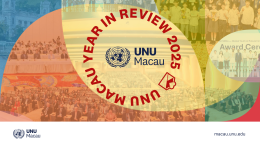In August 2023, the United Nations Secretary-General announced the establishment of a Multistakeholder High-Level Advisory Body on Artificial Intelligence (AI), scheduled to convene in the last quarter of the year. The primary objective of this body is to produce a report by the end of 2023 that will provide guidance to the UN and its Member States regarding the future of global AI governance. This initiative builds upon existing efforts, including the G7's push for global technical standards on AI and UNESCO's recommendations on the ethics of AI, signed by all UNESCO Member States.
The purpose of this Technical Note, an output of UNU-CPR's "Breakthrough for People and Planet" initiative, is to outline the key questions surrounding global AI governance, aiming to inform the UN's ongoing efforts. It is based on the third recommendation of Shift 6 in the report of the UN's High Level Advisory Board on Effective Multilateralism (HLAB), which calls for a multilateral agreement on establishing a global architecture for AI, rooted in common standards and approaches. The Technical Note also draws from insights gathered during a workshop held at UNU-CPR in July 2023.
The document is structured into three main sections:
A Rationale for the UN-led Global AI Governance on AI
This section emphasizes the need for global AI governance due to the numerous risks associated with AI. In an era of digital globalization, individual Member States cannot effectively regulate AI independently, making global coordination essential. The UN's role in coordinating efforts with regional organizations like the EU, African Union, and Council of Europe is crucial, especially for engaging the Global South. The paper also highlights the importance of AI governance in achieving the Sustainable Development Goals (SDGs), emphasizing fairness and accountability. It acknowledges the necessity of capacity building and the protection of human rights in AI development and usage.
A description of the building blocks of a global architecture for AI, adapted from existing models of global governance
This section outlines the components of a global architecture for AI, encompassing ethical norms, legal norms, and technical norms. While ethical and technical aspects have been explored, the legal dimension is gaining importance. The discussion references existing global governance models that could inspire the creation of a new global governance mechanism for AI.
Four decision points for members of the High-Level Advisory Body on AI, related to agile policymaking, multistakeholder engagement, interoperability, and scope
Four key decision points for the Multistakeholder High-Level Advisory Body on AI are presented. These points relate to agile policymaking to address the ever-changing nature of AI; multistakeholder engagement that involves governments, the private sector, and civil society; the need for interoperability and coordination among UN entities and other global governance efforts; and the scope of governed AI, which includes considerations of civilian versus military use and high-risk versus low-risk applications.
Access "A Global Architecture for Artificial Intelligence" here.
Suggested citation: Fournier-Tombs Eleonore , Siddiqui Muznah , Céline Castets-Renard and Valère Ndior. A Global Architecture for Artificial Intelligence : UNU-CPR, 2023.

